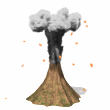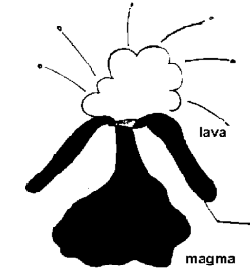BACKGROUND:
 Children are fascinated with the spectacular volcanic
eruptions that occur throughout the world. Volcanoes are very important to
interpret the outer portion of the Earth, as well as to the Earth’s
history. As the new Earth developed 4.5 billions years ago, volcanoes
erupted, emitting not only lava, but steam, and other gases. This steam,
through eons of time, was one of the major sources of water on this planet.
The volcanic rocks (igneous rocks) produced by volcanoes make up much of the
Earth’s surface.
Children are fascinated with the spectacular volcanic
eruptions that occur throughout the world. Volcanoes are very important to
interpret the outer portion of the Earth, as well as to the Earth’s
history. As the new Earth developed 4.5 billions years ago, volcanoes
erupted, emitting not only lava, but steam, and other gases. This steam,
through eons of time, was one of the major sources of water on this planet.
The volcanic rocks (igneous rocks) produced by volcanoes make up much of the
Earth’s surface.
 Explaining why volcanoes occur in certain places
requires a knowledge of plate tectonics, specifically the three different
types of plate boundaries. Essentially, a variety of processes at plate
boundaries cause rocks to melt. This molten rock, called magma, moves upward
because it is hot and buoyant. It erupts to form volcanoes. Some volcanoes,
like the Hawaiian Island chain, are not related to plate tectonics: these
volcanoes form over "hotspots", which are sources of magma (molten
rock) the have their origin below the plates.
Explaining why volcanoes occur in certain places
requires a knowledge of plate tectonics, specifically the three different
types of plate boundaries. Essentially, a variety of processes at plate
boundaries cause rocks to melt. This molten rock, called magma, moves upward
because it is hot and buoyant. It erupts to form volcanoes. Some volcanoes,
like the Hawaiian Island chain, are not related to plate tectonics: these
volcanoes form over "hotspots", which are sources of magma (molten
rock) the have their origin below the plates.
Volcanoes
produce volcanic rocks such as lava, which is magma that has cooled on the
surface of the Earth. If the magma cooled inside the Earth, it forms what is
called plutonic rock. Both plutonic and volcanic rocks are types of igneous
rocks. Melted rocks that have hardened are considered igneous rocks.
When magma erupts on the Earth’s surface, it often
builds a volcano, which is basically a pile of cooled volcanic rock.
Volcanoes may be hill to mountain size. However, not all hills and mountains
are volcanoes. Some are tectonic features, constructed by mountain building
, which often happens at plate boundaries, just like volcanism. Others are
erosional features, leftovers from earlier tectonic mountains.
Volcanoes are impressive to young students. In the
eyes of a child, the fire and disaster caused by volcanoes are simply
"awesome." This Pre Lab capitalizes on your students’ curiosity
by introducing the science of volcanic eruptions.
PROCEDURE:
- Discuss and introduce the concept that not all mountains are
volcanoes. Show pictures or videos of mountains that are volcanoes and ones that
are non volcanic (see pictures below). The Internet also has many
wonderful pictures. Here are a few recommended websites, but doing using
any search engine will not only bring you pictures but videos.
http://www.geo.mtu.edu/volcanoes/
University of Michigan volcano sites around the world.
http://vulcan.wr.usgs.gov/home.html
The US Geological Survey Cascades Volcano Observatory. Excellent
information on US volcanoes, as well as plate tectonics and geologic
hazards
If you have volcanic rocks in your area, discuss them with the students.
If you do not know if the mountains are a result of an old volcano,
consult your local university's geology department, natural history
museum.
- Explain to the students that volcanoes produce rocks from cooled down
melted lava. The melted rock inside the Earth is called magma and when
it erupts on the surface it is called lava. Discuss how lava comes from
a volcano. Ask the students about their own experiences with volcanoes.
- Read Lucy Lava to illustrate how lava moves upward.
Hot rock is less dense than surrounding rock and moves upward.
- Announce that you are going to have them play a game called "Like
a Volcano." Have the students lie in a prone position on the floor
and imagine that they are magma inside the volcano. Have them pop up or
"erupt," mimicking the eruption of lava. Remember magma inside
the Earth, lava on its surface. Repeat this activity several times,
reiterating that magma is in the Earth, and lava is outside the Earth.
- You may want to have samples of volcanic rocks in your classroom, but
do not use the same samples for the hands-on lab. You can usually get
large "lava" rocks (basalt or pumice) by going to a local
landscaping supply house.